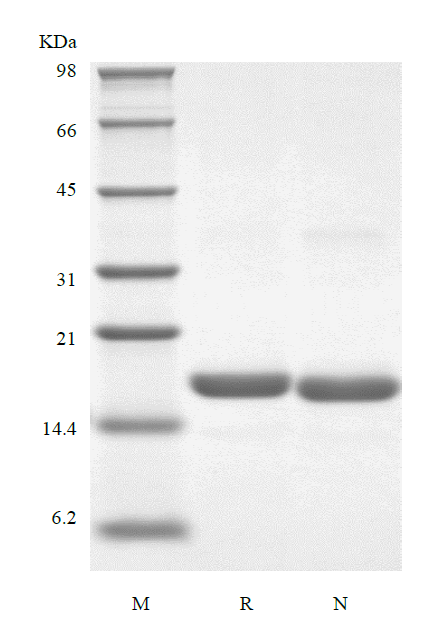- Synonyms
- CSF-3, MGI-1G, GM-CSF beta, Pluripoietin
- Source
- Escherichia coli.
- Molecular Weight
- Approximately 18.7 kDa, a single non-glycosylated polypeptide chain containing 174 amino acids.
- AA Sequence
- TPLGPASSLP QSFLLKCLEQ VRKIQGDGAA LQEKLCATYK LCHPEELVLL GHSLGIPWAP LSSCPSQALQ LAGCLSQLHS GLFLYQGLLQ ALEGISPELG PTLDTLQLDV ADFATTIWQQ MEELGMAPAL QPTQGAMPAF ASAFQRRAGG VLVASHLQSF LEVSYRVLRH LAQP
- Purity
- > 98 % by SDS-PAGE and HPLC analyses.
- Biological Activity
- Fully biologically active when compared to standard. The ED50 as determined by a cell proliferation assay using murine NFS-60 cells is less than 0.1 ng/ml, corresponding to a specific activity of > 1.0 × 107 IU/mg.
- Physical Appearance
- Sterile Filtered White lyophilized (freeze-dried) powder.
- Formulation
- Lyophilized from a 0.2 μm filtered concentrated solution in 10mM sodium acetate buffer, containing 5 % trehalose, pH 4.0.
- Endotoxin
- Less than 1 EU/μg of rHuG-CSF as determined by LAL method.
- Reconstitution
- We recommend that this vial be briefly centrifuged prior to opening to bring the contents to the bottom. Reconstitute in sterile distilled water or aqueous buffer containing 0.1 % BSA to a concentration of 0.1-1.0 mg/mL. Stock solutions should be apportioned into working aliquots and stored at ≤ -20 °C. Further dilutions should be made in appropriate buffered solutions.
- Stability & Storage
- Use a manual defrost freezer and avoid repeated freeze-thaw cycles.
- 12 months from date of receipt, -20 to -70 °C as supplied.
- 1 month, 2 to 8 °C under sterile conditions after reconstitution.
- 3 months, -20 to -70 °C under sterile conditions after reconstitution.
- Usage
- This material is offered by Shanghai PrimeGene Bio-Tech for research, laboratory or further evaluation purposes. NOT FOR HUMAN USE.
- SDS-PAGE

- Reference
- 1. Scarffe JHandKamthan A. 1990. Cancer Surv, 9: 115-30.
2. Fattorini L, Xiao Y, Li B, et al. 1994. J Med Microbiol, 40: 129-33.
3. Tsavaris N, Kosmas C, Gouveris P, et al. 2004. Med Sci Monit, 10: PI24-8.
4. Shochat E, Rom-Kedar V, Segel LA. 2007. Bull Math Biol, 69: 2299-338.
5. Cornish AL, Campbell IK, McKenzie BS, et al. 2009. Nat Rev Rheumatol, 5: 554-9.
- Background
- Granulocyte colony stimulating factor (G-CSF) is a pleiotropic cytokine. It is mainly produced by monocytes and macrophages upon activation by endotoxin, TNF-α and IFN-γ. Besides, many other cell types can secreted this protein after LPS, IL-1 or TNF-α activation, which are fibroblasts, endothelial cells, astrocytes and bone marrow stromal cells. Various carcinoma cell lines and myeloblastic leukemia cells can express G-CSF constitutively. G-CSF is cytokine that acts in hematopoiesis by controlling the production, differentiation, and function of 2 related white cell populations of the blood, the granulocytes and the monocytes-macrophages. In addition it may function in some adhesion or recognition events at the cell surface.
In humans, two distinct cDNA clones for G-CSF, encoding 207 and 204 amino acid (a.a.) precursor proteins, have been isolated. Both proteins have a 30 a.a. signal peptide and have identical amino acid sequences except for a three a.a. insertion (deletion) at the 35th a.a. residue from the N-terminus of the mature protein. Human G-CSF is 73 % identical at the amino acid level to murine G-CSF and the two proteins show species cross-reactivity.









 COA Application
COA Application


